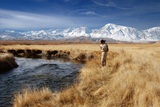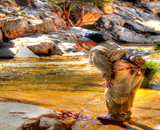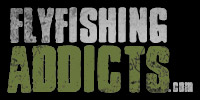Reprinted from the Loop.
Train it and Trust it
Peter Hayes, CBOG
As they say, practice makes perfect—and the
subject of practice is dear to my heart. If you
wish to catch more fish then one of the most
obvious and beneficial ways to do this is to
practice as much as you can. Not all of us
can find the time and place to practice
regularly in a real life fishing situation, but the
local park is a great substitute.
I have practiced my accuracy and distance fly
casts for more than 30 years so that I could
be the best in the world at it. Constant and
intensive practice has stood me in good
stead whenever the opportunity to fish has
arisen.
Just yesterday I waded a medium-sized local
freestone river with Montana fishing guide,
Chuck Ravetta. We sometimes took turns
fishing, each watching the other. Other times
we waded side by side, fishing ahead as we
went. We prospected likely bubble lines,
current seams and sneaky bank side lies.
On a day like this, on this stretch of the river,
the average client could expect to catch a
dozen or so fish of up to a pound and a half.
On this occasion Chuck and I managed
somewhere between 50 and 60. The largest
was three pounds.
What is the difference between guide and
client?
I am a constant and passionate analyzer of
fishing situations. This comes partly from my
engineering background and partly from my
competitive nature. As a guide, it is my job to
work out ways for clients to catch more fish.
Whilst fishing with Chuck I found myself
constantly studying his slightly different style.
Then, at the end of the day I compared our
wonderful day with the day previously where I
guided two clients on the same water. There
were two major stand-out differences:
1.Presentation
In a four-hour fishing session with Chuck I
rarely saw an inaccurate cast. Instead there
were pinpoint accurate casts to the middle of
bubble lines, perfect shots just inches from
banks and long shoots into the shadows feet
under overhanging tea-tree.
When it was necessary to draw a fish out
from cover, the hopper went down with a firm
‘PLOP,’ but without a hint of leader crash.
Sometimes the very next cast would be to a
sipping fish in the middle of a glassy calm
pool and this delivery would land like thistle
down just three feet to the side.
Several fish came from way under
overhanging scrub and on these occasions a
tighter loop, faster line speed cast was
required to ping the fly deep under the cover.
There were a dozen or so fish that came to
backhand side casts and to bow and arrow
casts that we could both manage effortlessly.
Many clients just couldn’t possibly expect to
catch these fish.
We could both recognize the need for
different shots and we could make them –
first time. It was all done with ease and
whilst I rarely fish with anglers of Chuck’s
ability I could recognize the beauty in the
situation. It was a very pleasant and
satisfying day.
2. Mending
Mending for drag-free drifts was the second
glaringly obvious difference between the
guides and the clients. Very often an aerial
mend was enough but if it wasn’t then
constant attention was given to water
mending. There were dozens of fish that
would not have been caught without good
mending technique. Chuck is the best I have
ever seen at this. He works with drift boats on
huge and fast rivers with complex current
situations. I am sure this tiny river was a soda
for him. Chuck mends ten times better than I
do. It is because he is practiced at it.
Now Train It – Casting Practice
First, find a clear area in the park.
Use an
orange practice line and preferably a double
taper. Try to practice on a sunny day with
good visibility.
Study your loops both front and back. Learn
to watch every back cast loop. Study the loop
shape, speed and trajectory. Learn to throw
tight loops, open loops and avoid tailing loops
with super-smooth rod loading. Spend time
on understanding the mechanics of the cast.
Get a good handle on smooth rod loading
and tight loop forming.
Learn and understand good haul technique.
Do all this false casting practice-side-onto-
the-wind so that the back and forward cast
are affected equally by the side wind. Once
you have good control of the rod tip
movements and great loop control it is time
for fishing practice.
Fishing Practice
If you want to get better at fishing you must
spend some quality time practicing fishing
drills. If you are a trout fisherman don’t just
go down to the local park and stand in the
middle of the oval and throw 60 feet directly
downwind. For some reason this is what
most people practice. In a year of fishing I
might just once get a long downwind cast to a
fish without obstructions around.
Instead, you need to find an area with lots of
trees and other obstacles like park benches,
fences etc. Put some bright yarn on your
leader then walk through the trees casting to
imaginary fish. Kneel and cast, sit and cast,
cast backhand cast left hand, pull your rod in
half and cast just your top joint.
Learn curve casts, learn tight loops and long
shooting deliveries. Learn good full-leader
extension then learn the pile cast. Cast into
the wind and across the wind with the wind
on your casting side. Learn what I call spatial
awareness and avoid treeing your fly on the
back cast.
Delivery practice
Your final practice session ideally should be
on water, where you can assess your delivery
technique. Learn to forcefully plop the fly
down first with the leader landing gently
afterward (almost a Tuck Cast), learn to fully
extend the leader with high line speed and a
tight loop just 2 feet above the water. This will
cause some rebounded slack and land the
flies like thistledown from what I call a ‘gravity
fall.’
The delivery that will cost you lots of fish is
the ‘crash landed fly and crumpled leader’
that pile drives hard onto the water surface.
Typically the fly lands on the water just half a
leader ahead of the nail knot. The fly, leader
and often the final few feet of fly line are
driven down forcefully onto the surface of the
water. This is a ‘scare the clappers out of
them’ approach on a calm pool.
Now Trust It
Once you have worked on your park cast you
must learn to trust it in a fishing situation.
When fishing you must learn to believe in
your ability, trust that your hand-eye
coordination will kick in when it is required.
It is OK to first study the lie, assess the
current flow get spatially aware, etc., but then
you must focus all your energy on the target
and start swinging the rod. This is no time to
think of the technical or mechanical aspects
of the cast. Believe in yourself, believe you
can make the shot, believe you have done it
successfully one hundred times before. You
can do it and you will. We are hunters by
nature and this is how we hunt . You must
learn to be instinctive. Never look up at your
rod tip and never watch your back cast when
you are looking for an accurate delivery to a
fish. Simply look at the target and believe in
yourself. Don’t over think it under any
circumstances
REALTIME FLOWS  U. Kern: n/a cfs
U. Kern: n/a cfs
 L. Kern: 1341 cfs
L. Kern: 1341 cfs
 E.W: 312 cfs
E.W: 312 cfs
 U. Owens: 108 cfs
U. Owens: 108 cfs  L. Owens: 496 cfs 09/02/19 1:15 PM PST
L. Owens: 496 cfs 09/02/19 1:15 PM PST
Train it and Trust it
3 posts
• Page 1 of 1
Train it and Trust it
Make Fly Fishing Great Again!
-

fly addict - Posts: 2560
- Joined: August 3rd, 2008, 1:57 pm
- Location: In your honey hole!
Re: Train it and Trust it
Sounds like someone I know! 
"Tomorrow is the most important thing in life. Comes into us at midnight very clean. It's perfect when it arrives and it puts itself in our hands. It hopes we've learnt something from yesterday."
John Wayne
John Wayne
-

Wildman - Site Admin
- Posts: 3747
- Joined: August 17th, 2008, 2:07 pm
Re: Train it and Trust it
And to think that when I fished with Mark at KM last month I thought it was pure luck that he out fished me 10 to 1!! 

- tomsakai
- Posts: 1109
- Joined: March 27th, 2009, 7:22 am
- Location: The OC

